
This is a 220 year old telescope, made by one of the best makers in the Eighteenth Century, Jesse Ramsden, from around 1780-1790. As such it is way ahead of its time, a compact unit with three brass draws, so it would be useful at sea, but also for Officers in the Cavalry, where a smaller size was needed: plus it would have had a good set of lenses, making it optically excellent. Ramsden, who worked for Peter Dollond, was also related to the Dollond family after he married Sarah Dollond in 1766, Peter’s sister: she was the daughter of John Dollond. So he presumably could access the best suppliers, and had free use of the Dollond Patent and other technology.

The lens fittings in the first draw: only the first and fourth lenses were present.
What we can see here looks really good, but it is lacking three vital components: two lenses from the eyepiece draw tube, and the objective lenses. So there are only actually two lenses still present in this unit. Nevertheless it makes an excellent space model.
It has obviously had some hard times, with the mahogany barrel being crushed at some point, then bound together with varnish, plastic film and a sail-cloth binding. Some of these can be seen in the “Before” pictures during the restoration. The barrel was stripped of sail cloth and other things, glued back together and then polished.

As received, but after removal of the sail cloth! Showing the crushed mahogany barrel.

Barrel glued, filled and repolished, with a polished brass end fitting.
Jesse Ramsden
Jesse was born in Salterhebble, Yorkshire, but worked in London for Peter Dollond, George Adams and Jeremiah Sisson, an associate of Nevil Maskelyne, the Astronomer Royal. He started business on his own account in 1763, and had many notable apprentices, including William Cary. By 1772 he was working at 199 Piccadilly, with a workshop at #196. He was appointed FRS in 1786, and won the Copley Medal in 1792. When he died in 1800 his employee Matthew Berge took over the business, working at 199 Piccadilly till 1817.
Other Berge and Ramsden telescopes feature on this website, as the best available at that time. The smaller Ramsdens in my collection were described in an early post, dated 5 February 2014. The closest to this telescope would be the large five-draw Berge (Late Ramsden) posted on 9 April 2014.
Construction

Re-polished first draw tube, showing the breaks in the tube for the lenses.
The telescope is a classic design of four eyepiece lenses and an objective pair. Before the advent of the lens cartridges the first draw was divided into four or more sections, screwed together to form one smooth OD tube. At each break a lens carrier is inserted: not only do the tube sections have different screw threads, so that they cannot be put in the wrong order, but the lens mounting threads are all different in diameter and/or thread, so that they cannot be inserted in the wrong place.
The 4th lens mount, closest to the objective, has a thread of 7/8”. This is present.
The third lens mount has a thread OD of 13/16”. This is absent.
The second lens mount has a thread OD of 1”: the tube OD is 1+1/16”. This lens is absent.
The first lens mount, at the eyepiece, has a thread OD of 13/16”, but this lens, which is present, is too large to screw into the third lens mount position, so there is no possibility of confusion there.
On many of the pieces that make up this 3-draw scope, the code XV is visible, to identify the drawtubes and mounting adaptors used on the production line. Noticeably one of the mounting flanges for a draw is labelled ‘15’ in ink, ie in a modern number format, so is maybe a replacement in production.
The objective lens assembly, which is absent, would screw through the brass fitting (now ‘only-just’) into the mahogany barrel, with four grub screws: much of the barrel wood has broken away with damage and wear, so only really one grub screw is holding the fitting in place. Interestingly the brass at the other end of the barrel has the same four grub screws, and these screw into an inner brass cylindrical (1/2” long) retaining ring, inside the ID of the wood – it makes for a strong wood sandwich between the brass fitting parts. The thread for the objective lens assembly is 1+13/16” diameter.

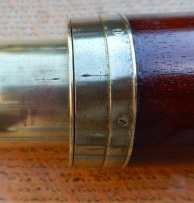
Overall the telescope is 27.5” long when fully open, 9+3/8” when closed. There is no sunshade or lens cap present on the objective – undoubtedly there would have been a lens cap: the eyepiece has a brass slider over the lens aperture. The barrel is 1+7/8” OD, and the draws are 1.25”, 1+3/16” and 1+1/16” OD. Most of the draws feature a location arrow, presumed to indicate the best orientation for the tubes, when the arrows are aligned.
What now?

The three brass draws, re-polished
Undoubtedly this is now an excellent space model, but it needs three lenses to work: adding these from a C19th spare telescope would not produce the quality needed for a Ramsden scope, even if they were found with the right size, strength and thread patterns. The chance of finding a good C18th lens set to fit, that would not ruin a different telescope specimen, is very small.
It’s still a good Ramsden 1780 telescope space model, and as such has a significant value!
Why do I say 1780, rather than later? First the fact that it has a split draw tube, and does not use cartridges. Second because the engraving on the first draw has the initial letters next to the eyepiece end of the telescope: this was the fashion, or standard, earlier in the 1700s, ie between say 1765 and 1790. After around 1790 the fashion changed, and the signature was on the other side of the telescope. Its not an exact date change, just an indicator – but it makes this scope probably earlier than 1790.
Accession Number #289. Acquired and then renovated in August 2016.
As delivered photos
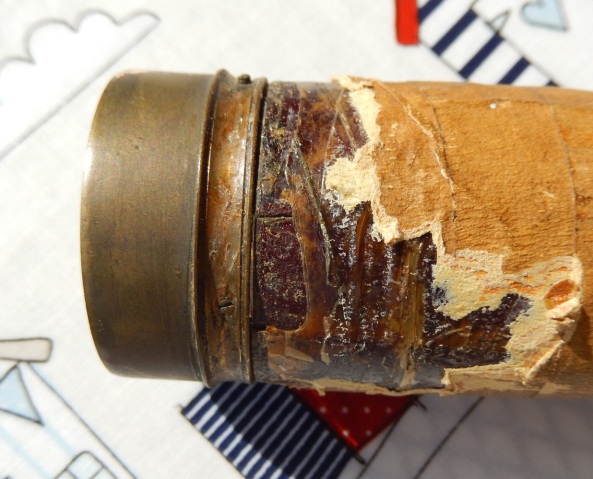
The barrel as delivered, covered in sail cloth, over a form of plastic binding.

The draws on the left are not repolished, as received: the right hand side shows the first draw polished, and the barrel stripped down to the wood and the cracks re-glued.



 The barrel has an attractive taper, which goes from 2” OD at the objective end, down to 1.25” OD at the eyepiece end: this is clad in thick brown leather, solidly laced along the length. Whilst it is not too heavy, the tapered tube has a narrow straight tube of maybe half the total taper length inside at the eyepiece end.
The barrel has an attractive taper, which goes from 2” OD at the objective end, down to 1.25” OD at the eyepiece end: this is clad in thick brown leather, solidly laced along the length. Whilst it is not too heavy, the tapered tube has a narrow straight tube of maybe half the total taper length inside at the eyepiece end.


 Also inside the case was a soft cushioned end piece, which fitted the eyepiece end of the telescope – so obviously this part of the case was meant to accept the eyepiece, rather than the objective. On the back of the cushioning the words forming the remains of some writing were in French, so along with the appearance of the scope this convinced me that the telescope was actually a French design, probably sold in England. Because it is such a small pocket telescope version, you assume it was sold to a country gent, to be carried in his pocket.
Also inside the case was a soft cushioned end piece, which fitted the eyepiece end of the telescope – so obviously this part of the case was meant to accept the eyepiece, rather than the objective. On the back of the cushioning the words forming the remains of some writing were in French, so along with the appearance of the scope this convinced me that the telescope was actually a French design, probably sold in England. Because it is such a small pocket telescope version, you assume it was sold to a country gent, to be carried in his pocket. The cartridge in the first draw was fine, but the second cartridge appeared to be at the end of the first draw. It became obvious that the telescope in fact had a sixth draw, and this draw was very stiff, possibly because it had been distorted. Withdrawing the second cartridge showed that the second, inner lens was missing. This lens was located – it was jammed up the first draw tube, held in place because its own over-sized knurled mounting ring was too big to slide easily inside the first draw, when the scope was fully collapsed. This had possibly led to the distortion of the first draw, and it does appear to be a design fault.
The cartridge in the first draw was fine, but the second cartridge appeared to be at the end of the first draw. It became obvious that the telescope in fact had a sixth draw, and this draw was very stiff, possibly because it had been distorted. Withdrawing the second cartridge showed that the second, inner lens was missing. This lens was located – it was jammed up the first draw tube, held in place because its own over-sized knurled mounting ring was too big to slide easily inside the first draw, when the scope was fully collapsed. This had possibly led to the distortion of the first draw, and it does appear to be a design fault. Even more interesting was that there was a supplier name engraved on the first draw, which was “S & B Solomons, 39 Albemarle St, London”. The Solomons were opticians and spectacle makers, and accepted London suppliers of telescopes and microscopes: it is possible that this was an imported French-made pocket telescope, brought in to provide their ‘Landed Gentry’ customers with impressive pocket-sized devices. Albemarle Street is off the Strand in Central London, and Samuel and Benjamin Solomons were operating there from 1840 to 1875, throughout the early Victorian period.
Even more interesting was that there was a supplier name engraved on the first draw, which was “S & B Solomons, 39 Albemarle St, London”. The Solomons were opticians and spectacle makers, and accepted London suppliers of telescopes and microscopes: it is possible that this was an imported French-made pocket telescope, brought in to provide their ‘Landed Gentry’ customers with impressive pocket-sized devices. Albemarle Street is off the Strand in Central London, and Samuel and Benjamin Solomons were operating there from 1840 to 1875, throughout the early Victorian period.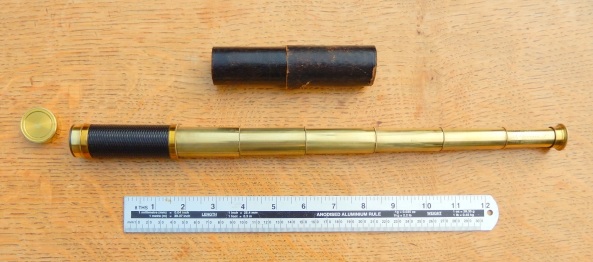

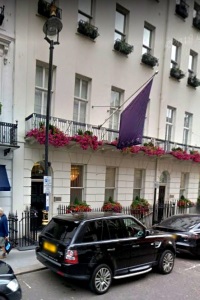


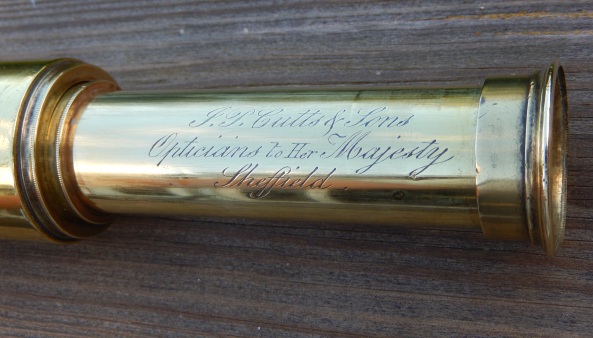
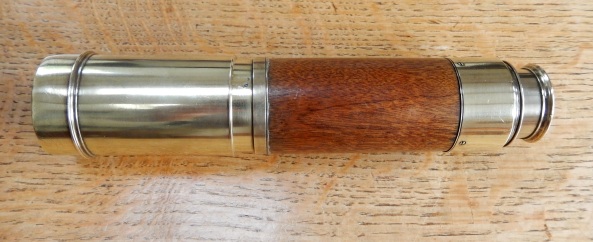
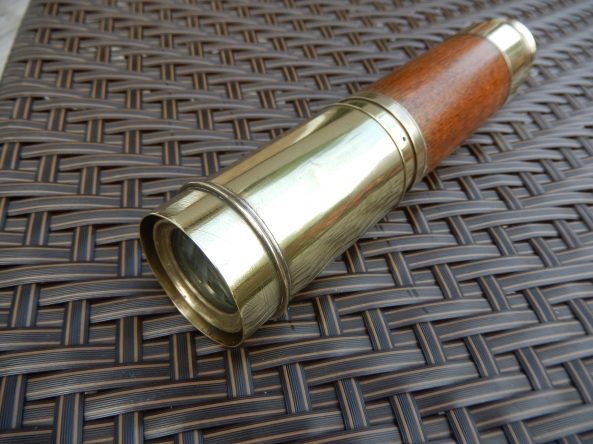

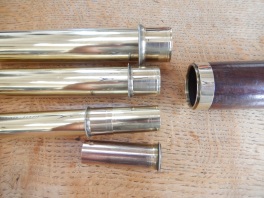

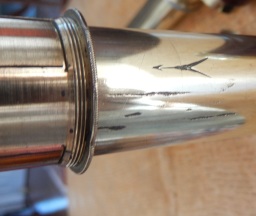 ach draw has an arrow, which is taken to indicate how the tubes should be aligned to get the best performance. The air hole in the top of the third draw is to let the air compressed inside the telescope discharge easily to atmosphere.
ach draw has an arrow, which is taken to indicate how the tubes should be aligned to get the best performance. The air hole in the top of the third draw is to let the air compressed inside the telescope discharge easily to atmosphere. s a blemish on the surface, where it appears a 4-5mm diameter hole has been filled in, asa repair.
s a blemish on the surface, where it appears a 4-5mm diameter hole has been filled in, asa repair.